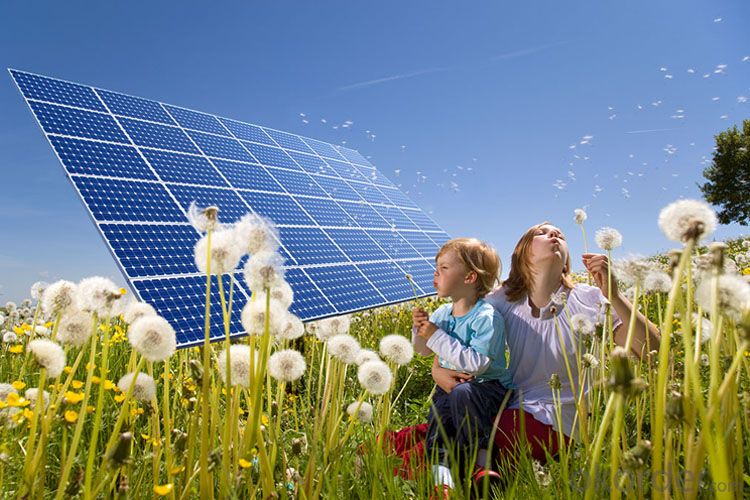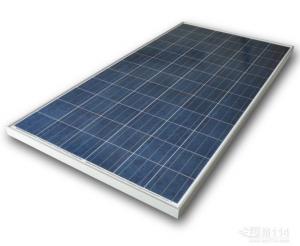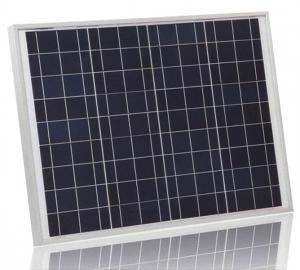Solar Panels Europe - High Quality & Efficient Poly205W
- Loading Port:
- Shanghai
- Payment Terms:
- TT OR LC
- Min Order Qty:
- 10000 watt
- Supply Capability:
- 100000000 watt/month
OKorder Service Pledge
OKorder Financial Service
You Might Also Like
Specification
1.Product Description:
Solar Module is the core part of solar PV power systems, also is the highest value part of it. The function of Solar Module is to convert the sun's radiation to electrical energy, or transfer it to battery and store in it, or to drive the load running.The Product has been widely used in space and ground, it mainly used for power generation systems, charging systems, road lighting and traffic signs areas. It could offer a wide range of power and voltage, and with high conversion efficiency, and long service life.
2. Standard Test Conditions of Polycrystalline Silicon Solar Panel:
The opto-electrical specifications shown below are stabilized values being measured at Standard Test Conditions, Irradiance: 1000W/m2, Spectrum: AM1.5 at 25°C, The info below is subject to manufacturing tolerances. Where appropriate minutes of measurement are available and are used for the dimensioning of the installation.
Advantages of Polycrystalline Silicon Solar Panel
• CNBM Solar performance guarantees for 25 years
• 12 years guarantee for workmanship
• Timeliness of delivery
• Quality Products certified (TÜV, UL, CE, ISO)
3. Production Flow

4. The Pictures of Products





5. FAQ
We have organized several common questions for our clients,may help you sincerely:
1. How about your company
CNBM Solar photovoltaic (PV) Panel has various wattage from 1.5W to 315W to meet the demand of every customer. It is the optimal choice for both on-grid and off-grid power systems. CNBM Solar panel offers high performance of power warranty and good after sale service, we have professional people to reply your problem anytime.
2. What’s price per watt?
A: It’s depends on the quantity, delivery date and payment terms of the order. We can talk further about the detail price issue. Our products is high quality with lower price level.
3. How do you pack your products?
We have rich experience on how to pack the panels to make sure the safety on shipment when it arrives at the destination.
4. Can you do OEM for us?
Yes, we can.
5. How long can we receive the product after purchase?
In the purchase of product within three working days, We will arrange the factory delivery as soon as possible. The perfect time of receiving is related to the state and position of customers. Commonly 7 to 10 working days can be served.
- Q: If i took a lazier pointer and aimed it a solar panel would it take in the light. Also what types of lights would work on a solar panel like L.E.D, uv light bulbs.
- Build okorder /
- Q: How do solar panels affect the resale value of a home?
- Solar panels can have a positive impact on the resale value of a home. Studies have shown that properties with solar panels tend to sell faster and at a higher price compared to homes without them. Potential buyers view solar panels as a valuable and eco-friendly feature, leading to increased buyer interest and willingness to pay a premium for a home equipped with solar power.
- Q: Solar panels are all divided into these squares, forming a grid like pattern. Is it possible to have a single piece of solar panel?
- Yeah, but if something happened to it you would have to replace the whole thing. This way you only need to replace a small bit of it if there's a problem. Plus, they're easier to transport.
- Q: Can solar panels be used for powering outdoor lighting?
- Yes, solar panels can be used to power outdoor lighting. Solar panels convert sunlight into electricity, which can be stored in batteries and used to power outdoor lights during nighttime. This allows for cost-effective and environmentally friendly outdoor lighting solutions.
- Q: Which kit did you use?How easy was it to build? How much did it cost to build the panels?How many kw or watts does it produce?Any other info on the kit or panels you built would be helpful.Thanks!
- sure, but if you don't know what you are doing you could really hurt or kill yourself. Basically you can do whatever you want on your side of the power meter and in the rare occurrence when your solar panels are producing more power that your home is using the meter will run backwards and you will be feeding power to the grid and theoretically reducing your power bill. At the very least you will be using less power from the grid
- Q: I hooked up a 2V solar panel to a small relay. The relay switches at 9V. When I have light shining on the panel it puts out aorund 3-4V, but when I hook it up directly to the relay it drops to V and doesn't switch the relay. Why? and How do I fix it?-2V Mono-Crystalline Solar Panel -JWD 7 4 reed relay
- Your solar panel output too little current that cannot be used to power the relay. Change the panel into 2V 500mA type shall work.
- Q: How do solar panels impact the local economy?
- Solar panels can have a positive impact on the local economy in several ways. Firstly, the installation and maintenance of solar panels create job opportunities, stimulating employment and income generation within the community. Additionally, the use of solar energy reduces reliance on imported fossil fuels, contributing to energy independence and reducing energy costs for both households and businesses. This can lead to increased disposable income, which can be reinvested in the local economy, supporting local businesses and promoting economic growth. Moreover, solar panels attract investment and contribute to the development of a clean energy sector, positioning the community as a hub for renewable energy innovations and attracting more businesses and investments in the long run.
- Q: Installing solar panels requires a big initial investment. Before I make this investment I want to check to see if the money I will save by installing solar panels will actually pay for this investment, in the long run. To calculate my savings, we should consider the area (square feet) I currently have available to install solar panels. Look at the available sunlight and its intensity in my state each month of the year. Based on this data estimate how much energy my solar panel will generate. Then compare that with how much energy (kWh) I currently consume based on my electricity bill.
- Your school spend $0,000 per month or per year?? Photovoltaic (Solar Panel) panels have a really large initial capital investment. If you live in a location (e.g. West Coast Desert, SoCal) where there are many sunny days so you might be able to break even quicker. Also note ,there are state and federal grants that can help ease the capital cost. Energy demand keeps going up so expect our current rates to double. People who have alternative forms like wind and solar will have the advantage when this time comes. Just think of when the US had it's oil crisis in summer of 2008, people with small efficient vehicles such as Prius's didn't feel the price increase like the people who bought cheaper large SUV's.
- Q: Can solar panels be used in areas with limited access to electricity?
- Yes, solar panels can be used in areas with limited access to electricity. This is because solar panels generate electricity using sunlight, so as long as there is sunlight available, they can generate power. In fact, solar panels are often used as a sustainable and reliable source of electricity in remote or off-grid locations where traditional power infrastructure is not available or feasible.
- Q: Can solar panels be installed on universities or educational campuses?
- Yes, solar panels can certainly be installed on universities or educational campuses. In fact, many educational institutions worldwide have already embraced solar power as a sustainable and renewable energy source. Installing solar panels on campuses not only helps reduce carbon emissions and combat climate change but also serves as a great educational tool for students to learn about clean energy and sustainability. Additionally, universities can benefit from cost savings on electricity bills and even generate surplus energy that can be fed back into the grid.
Send your message to us
Solar Panels Europe - High Quality & Efficient Poly205W
- Loading Port:
- Shanghai
- Payment Terms:
- TT OR LC
- Min Order Qty:
- 10000 watt
- Supply Capability:
- 100000000 watt/month
OKorder Service Pledge
OKorder Financial Service
Similar products
Hot products
Hot Searches
Related keywords




























